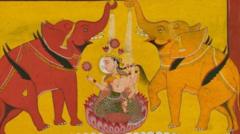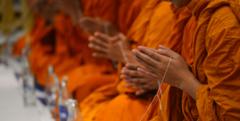**The exhibit, featuring 189 artifacts, highlights the fusion of religious traditions and artistic evolution from ancient India to modern times.**
**Exhibition Explores Evolution of India's Spiritual Art at British Museum**

**Exhibition Explores Evolution of India's Spiritual Art at British Museum**
**Discover the rich history and transformative journey of India's sacred art showcased in a new exhibition at the British Museum.**
The British Museum in London sets the stage for a captivating exploration of India's spiritual artistic journey in its new exhibition, "Ancient India: Living Traditions." Open from May 22 to October 19, this remarkable showcase features 189 incredible artifacts that span more than two millennia, inviting visitors to discover a spectrum of artistic expressions from ancient sculptures to intricate manuscripts.
The evolution of Indian art took a significant turn between 200 BC and AD 600, transitioning from symbolic representations to more vivid images that portrayed divine figures with human characteristics. Delving deep into the artistic narratives of Hinduism, Buddhism, and Jainism, the exhibit reflects on the interplay of common cultural roots that worshipped nature spirits, including serpents and peafowl. "Today we can't envision the veneration of these divine entities without their human forms, which makes this transformation absolutely fascinating," explains Sushma Jansari, the curator.
The exhibition is masterfully divided into five sections, exploring the early nature spirits and progressing through dedicated sections for each religion, ultimately showcasing their spread to regions like Cambodia and China. Among the exhibition's highlights is a striking two-sided sandstone panel showcasing the evolution of Buddha, illustrating the transition from symbolic representations to a vividly human depiction.
The display also highlights Jain art, notably focusing on the 24 enlightened teachers known as tirthankaras, with early representations crafted from pink sandstone. This exhibition holds unique significance as it is the first to explore the origins of the artistic traditions of all three religions in a unified manner, rather than treating them separately.
More than 40 pieces have been borrowed from 37 museums and libraries globally, adding to the visual richness of the presentation, which evokes the vibrant atmosphere of active religious shrines through multi-sensory elements including scents and sounds. Brief videos of practicing worshippers further bridge the past and present, emphasizing the ongoing relevance of these ancient traditions.
While the exhibition succeeds in visually narrating the flourishing of figurative art, it also raises questions about the reasons behind this transformative shift in visual language—a subject of ongoing scholarly debate. With such an engaging display, the British Museum's presentation invites a deeper understanding of the rich tapestry of India's spiritual art, extending its influence far beyond geographical borders.
The evolution of Indian art took a significant turn between 200 BC and AD 600, transitioning from symbolic representations to more vivid images that portrayed divine figures with human characteristics. Delving deep into the artistic narratives of Hinduism, Buddhism, and Jainism, the exhibit reflects on the interplay of common cultural roots that worshipped nature spirits, including serpents and peafowl. "Today we can't envision the veneration of these divine entities without their human forms, which makes this transformation absolutely fascinating," explains Sushma Jansari, the curator.
The exhibition is masterfully divided into five sections, exploring the early nature spirits and progressing through dedicated sections for each religion, ultimately showcasing their spread to regions like Cambodia and China. Among the exhibition's highlights is a striking two-sided sandstone panel showcasing the evolution of Buddha, illustrating the transition from symbolic representations to a vividly human depiction.
The display also highlights Jain art, notably focusing on the 24 enlightened teachers known as tirthankaras, with early representations crafted from pink sandstone. This exhibition holds unique significance as it is the first to explore the origins of the artistic traditions of all three religions in a unified manner, rather than treating them separately.
More than 40 pieces have been borrowed from 37 museums and libraries globally, adding to the visual richness of the presentation, which evokes the vibrant atmosphere of active religious shrines through multi-sensory elements including scents and sounds. Brief videos of practicing worshippers further bridge the past and present, emphasizing the ongoing relevance of these ancient traditions.
While the exhibition succeeds in visually narrating the flourishing of figurative art, it also raises questions about the reasons behind this transformative shift in visual language—a subject of ongoing scholarly debate. With such an engaging display, the British Museum's presentation invites a deeper understanding of the rich tapestry of India's spiritual art, extending its influence far beyond geographical borders.



















